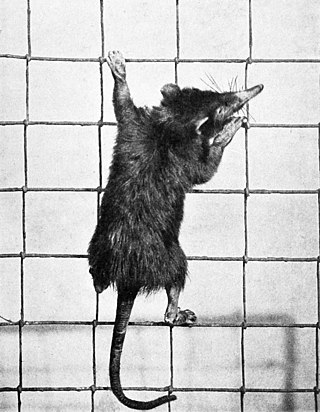
The Cuban solenodon or almiquí is a small, furry, shrew-like mammal endemic to mountainous forests on Cuba. It is the only species in the genus Atopogale. An elusive animal, it lives in burrows and is only active at night when it uses its unusual toxic saliva to feed on insects. The solenodons, native to the Caribbean, are one of only a few mammals that are venomous.

Hutias are moderately large cavy-like rodents of the subfamily Capromyinae that inhabit the Caribbean islands. Most species are restricted to Cuba, but species are known from all of the Greater Antilles, as well as The Bahamas and (formerly) Little Swan Island off of Honduras.
The dwarf hutia is a small, critically endangered, rat-like mammal known only from Cuba. Aside from tracks, it was last seen in 1937 and may be extinct. It gives birth to only a single offspring at a time, and is threatened by habitat loss and non-native species such as rats and mongoose. The dwarf hutia belongs to the hutia subfamily (Capromyinae), a group of rodents native to the Caribbean that are mostly endangered or extinct.
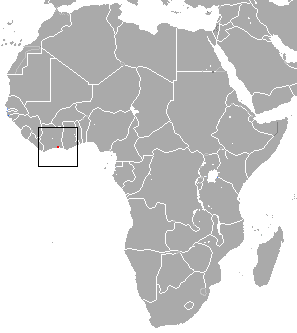
Wimmer's shrew is a white-toothed shrew found only in Côte d'Ivoire. It is listed as a critically endangered species due to habitat loss and a restricted range.
Garrido's hutia is a small, critically endangered, rat-like mammal found in coastal mangrove forests on Cuba and nearby islands. It is rarely seen and may be extinct. It is a member of the hutia subfamily (Capromyinae), a group of rodents native to the Caribbean that are mostly endangered or extinct. The only other species in its genus, the Desmarest's hutia, is also found only on Cuba.

The Jamaican coney, also known as the Jamaican hutia or Brown's hutia, is a small, endangered, rat-like mammal found only on the island of Jamaica. About the size of a rabbit, it lives in group nests and is active at night to feed on fruit, bark, and other plant matter. It is currently endangered by habitat loss, hunting, and non-native species; it persists only in remote mountains. The Jamaican coney belongs to the hutia subfamily (Capromyinae) and is the only surviving native mammal on Jamaica.
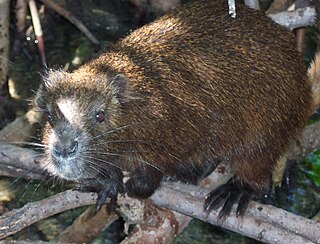
Desmarest's hutia or the Cuban hutia is a stout, furry, rat-like mammal found only on Cuba and nearby islands. Growing to about 60 cm (2 ft), it normally lives in pairs and feeds on leaves, fruit, bark and sometimes small animals. It is the largest living hutia, a group of rodents native to the Caribbean that are mostly endangered or extinct. Desmarest's hutia remains widespread throughout its range, though one subspecies native to the nearby Cayman Islands went extinct shortly after European colonization in the 1500s.
The arid thicket rat is a species of rodent in the family Muridae. It is found only in Sudan. Its natural habitat is subtropical or tropical dry shrubland. This species is currently listed on the "Nearly Threatened" list in its ranking of endangerment. Offspring of this species are commonly referred to as "kittens" or "pups". The female is referred to as a "doe", while the male is referred to as a "buck". These creatures commonly roam in groups, called a "horde", "pack", or "storm".
The Kondana soft-furred rat, also known as the Kondana rat or large metad, is an endangered species of rodent in the family Muridae. It is a nocturnal burrowing rat that is endemic to the Sinhgad plateau near Pune, Maharashtra, India. Its natural habitats are subtropical or tropical dry forests, subtropical or tropical dry lowland grassland, and urban areas. Major threats are habitat loss, overgrazing of vegetation, and disturbance from tourism and recreational activities.
The Hispaniolan edible rat is a recently extinct species of rodent in the family Echimyidae. It is the only species in the genus Brotomys. It was endemic to the island of Hispaniola in the Caribbean, in what is today the Dominican Republic and Haiti. Its natural habitat was subtropical or tropical moist lowland forests.

The Bahamian hutia or Ingraham's hutia is a small, furry, rat-like mammal found only in the Bahamas. About the size of a rabbit, it lives in burrows in forests or shrubland, emerging at night to feed on leaves, fruit, and other plant matter. It was believed extinct until rediscovery in 1964, and it remains the focus of conservation efforts. The Bahamian hutia is a member of the hutia subfamily (Capromyinae), a group of rodents native to the Caribbean, many of which are endangered or extinct.
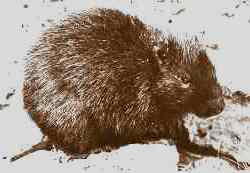
Cabrera's hutia is a small, critically endangered, rat-like mammal found only in Cuba. It lives in communal shelters in swamps and coastal mangrove forests, and is threatened by habitat loss. It is a member of the hutia subfamily (Capromyinae), a group of rodents native to the Caribbean that are mostly endangered or extinct.
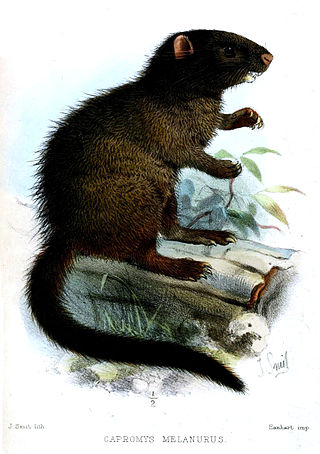
Mesocapromys is a genus of rodent in the subfamily Capromyinae. The genus is restricted to Cuba and associated islands.
The eared hutia or large-eared hutia is a small, endangered, rat-like mammal found only on the Caribbean island of Cayo Fragoso, off the north coast of Cuba. It lives in coastal mangrove forests and swamps, and is threatened by habitat loss. It is a member of the hutia subfamily (Capromyinae), a group of rodents native to the Caribbean that are mostly endangered or extinct.

The black-tailed hutia, also known as the bushy-tailed hutia, is a small, furry, rat-like mammal found only in Cuba. It lives in lowland moist forests and is threatened by habitat loss. It is a member of the hutia subfamily (Capromyinae), a group of rodents native to the Caribbean that are mostly endangered or extinct.
The Isla De La Juventud tree hutia or southern hutia is a subspecies of rodent in the subfamily Capromyinae. It is endemic to lowland moist forests on Isla de la Juventud in Cuba. It is threatened by habitat loss and is considered Critically Endangered by the IUCN Red List.

The prehensile-tailed hutia is a small, furry, rat-like mammal found only in forests on Cuba. It is the only member of the genus Mysateles. It climbs and lives in trees where it eats only leaves, and it is threatened by habitat loss. The prehensile-tailed hutia is a member of the hutia subfamily (Capromyinae), a group of rodents native to the Caribbean that are mostly endangered or extinct. There is one subspecies, M. prehensilis gundlachi.

The Samaná hutia is an extinct species of rodent in the subfamily Capromyinae. It was endemic to Hispaniola. Its natural habitat was subtropical or tropical moist lowland forests.











